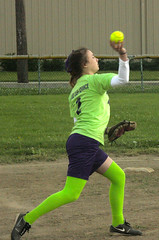
In a study of Poliomyelitis in children which can cause paralysis of shoulder girdle muscles leading to a flail shoulder, Joshua D. Miller, MD et al, in the Journal of Pediatric Orthopaedics:, September 2011 - Volume 31 - Issue 6 - p 679–682, stated that shoulder arthrodesis is indicated as a possible treatment for these children in order to stabilize the shoulder. This retrospective study reviewed all shoulder arthrodesis surgeries owing to complications of polio performed at a major medical institution between 1981 and 1996 to assess position of fusion, radiographic evidence of fusion, complications, and patient satisfaction., Methods: A review of medical records identified 11 patients undergoing 13 shoulder arthrodesis procedures, with a mean age of 14.7 years at the time of the procedure. Internal fixation was achieved with large cancellous screws in 8 patients and a Dynamic Compression Plate (DCP) plate in 5 procedures. Average follow-up period was 41 months. Eight patients were placed into a spica cast and 5 used a sling postoperatively., The results showed that shoulder arthrodesis surgery in this cohort resulted in an average position of fusion with 42.3 degrees of abduction, 23.8 degrees of flexion, and 26.2 degrees of internal rotation. Twelve of the 13 procedures assessed for radiographic union demonstrated fusion. The most common complications were malrotation and nonunion. Of the 13 procedures, 2 underwent humeral osteotomies for malrotation, and 1 with 6.5 mm cancellous screws required revision with a DCP plate owing to nonunion. Six patients underwent hardware removal, 3 of which were specifically owing to complaints of painful hardware. At final follow-up, no patient reported pain and all expressed satisfaction with their results and improved shoulder function after repair.His conclusion was that this study is the largest series of shoulder arthrodesis surgeries for treatment of patients with a flail shoulder from polio to date, providing a more thorough analysis of its efficacy as an indicated treatment., The ArmTutor together with its sister devices (HandTutor, LegTutor, 3DTutor) has proven very effective in improving range of motion of shoulders and elbows following surgery, disease or trauma. The innovative device is an electronic brace connected to a computer with dedicated software. It allows for repetitive exercises to the affected joint with augmented feedback. Currently used in leading U.S. and foreign hospitals the system can be administered by a physical therapist or the patient himself. It is available for children as well as adults and can be used together with tele rehabilitation.
No comments:
Post a Comment